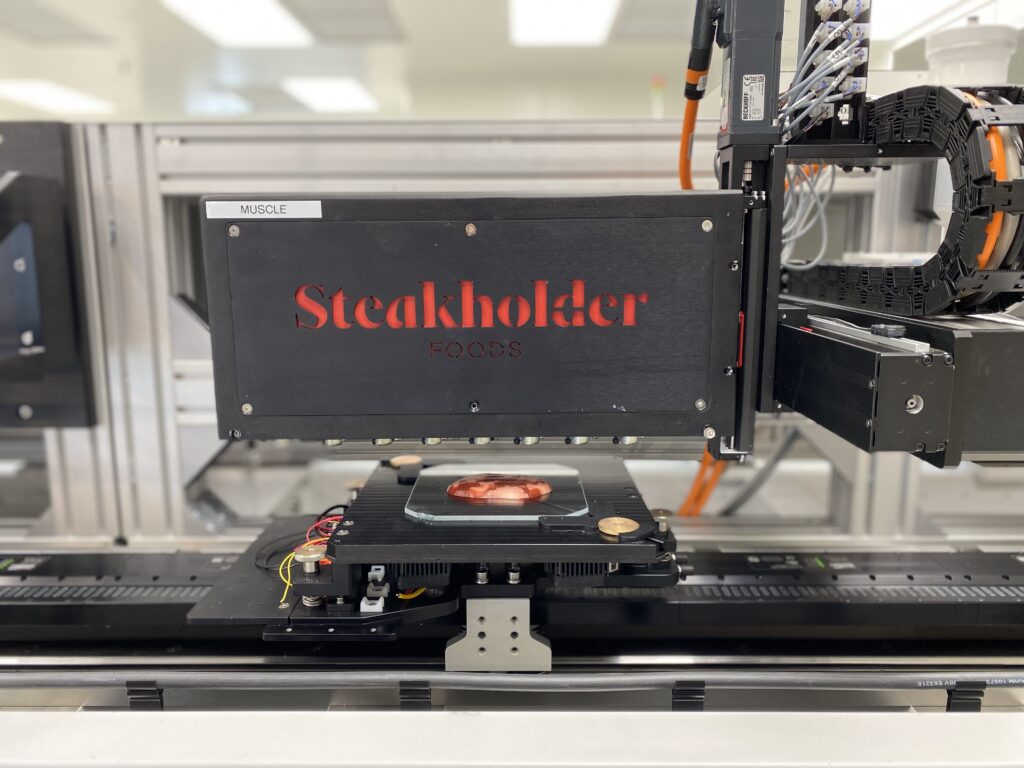Steakholder Foods (Nasdaq: STKH) has recently pulled back the curtain on its cutting-edge 3D bioprinting technology and bioinks, marking a significant leap in cultivated meat production.
Leading the charge is its newly unveiled SH Beef Steak Ink. The product is compatible with the brand’s proprietary bioprinting technology called Fusion, specifically designed for printing cultivated meats. The ready-to-use ink, containing a dry extract of ingredients, highlights Steakholder’s commitment to realistic and ethical meat alternatives. The company suggests that chefs and food producers can now explore possibilities, crafting customized cuts of meat tailored to specific palates. One of the big promises is that the bioinks unique formulation will “rival, if not surpass, the taste of traditional beef.” Part of the company’s vision is for the SH Beef Steak Ink to become an industry standard. This would make it accessible to a broad range of businesses in the cultivated meat sector.
Building on the success of the brand’s fish ink, SH Grouper Ink, the latest addition, further expands Steakholder Food’s lines of specialized inks. Looking ahead, Steakholder Foods plans to further broaden its offerings with a range of inks. These will replicate a variety of species, contributing to global food security while delighting palates worldwide. The company will soon announce the SH Pork Ink, also tailored for the Fusion printer currently used to create beef.
At the core of Steakholder’s tech advancements are its 3D printers, designed specifically for the cultivated meat and seafood industry. The Fusion 3D bioprinters optimize for meat products by employing a technology that extrudes paste materials through a narrow nozzle. This method creates a fiber texture that closely simulates natural meat fibers. In contrast, the brand’s DropJet 3D bioprinters, tailored for seafood products, use a technique involving the release of gel-based materials to construct a 3D structure. These specialized printers benefit from Steakholder Foods’ unique bioinks, ensuring the technology mimics meat and seafood textures.
Itamar Atzmony, Chief Engineering Officer at Steakholder Foods, commented, “Our mastery in 3D printing technologies extends beyond our existing fish and new beef inks, to a rich tapestry of species, offering a sustainable and ethical answer to global food security challenges. With our plant-based SH Inks as the canvas and cultivated cells as the brush strokes, we’re not just recreating meat and fish with our 3D printing technology; we’re revolutionizing the future of food, one print at a time.”
In a way, this moment in food technology can be compared to the rise of plant-based milks. Just as almond milk, soy milk, and others initially faced skepticism but gradually improved in taste, texture, and acceptance, bioprinted meats, too, may follow a similar trajectory. Today, many households embrace plant-based milks. The journey from niche food items to mainstream acceptance shows how new food products can evolve in a highly competitive market, especially in response to changing values and consumer needs. Over time, with further refinement and innovation, what seems novel now could become a staple of the future food industry.
As details continue to surface about Steakholder Foods’ bioprinters, the company’s direction becomes evident. They are setting new standards in this niche industry with two models within each bioprinting technology category. The Fusion series includes the Fusion Pro, designed for large-scale manufacturing and boasting a fully automated system. The Fusion Lite targets R&D, and with Steakholder Foods’ support, manufacturers can refine their printing capabilities.
Similarly, DropJet offers a Pro version that focuses on high-volume seafood production, capable of printing 20 fish in just five minutes. The DropJet Lite facilitates research and development in the seafood domain. Furthermore, it serves as the brand’s industrial-grade printer, capable of producing tons of plant-based, hybrid, or cultivated fish per month. Each nozzle connects to a different cell line, allowing them to build up textural differences: one for fat, another for muscle, and the last one for connective tissue. Users of the DropJet bioprinter can use the SH Grouper Ink, a dry extract of ingredients prepared for mixing. Additionally, the company has hinted at an upcoming release of SH Shrimp Ink, specifically tailored for its seafood-oriented DropJet printer.
Formerly known as MeaTech, the Israeli cultured meat tech developer received backing from Ashton Kutcher‘s investment group in 2021 and raised $12 million in venture rounds before going public in March 2021. Becoming the first Nasdaq-listed cultivated meat company drew even more attention and helped it price its U.S. initial public offering (IPO) at $10.30 while raising $25 million from its 2.4 million share offering. Today, the firm is known for 3D printed cultured eel to chicken fat. In essence, Steakholder Foods is not merely introducing new products but providing a comprehensive toolkit for the future of food production, combining bioprinting tech and bioinks.
